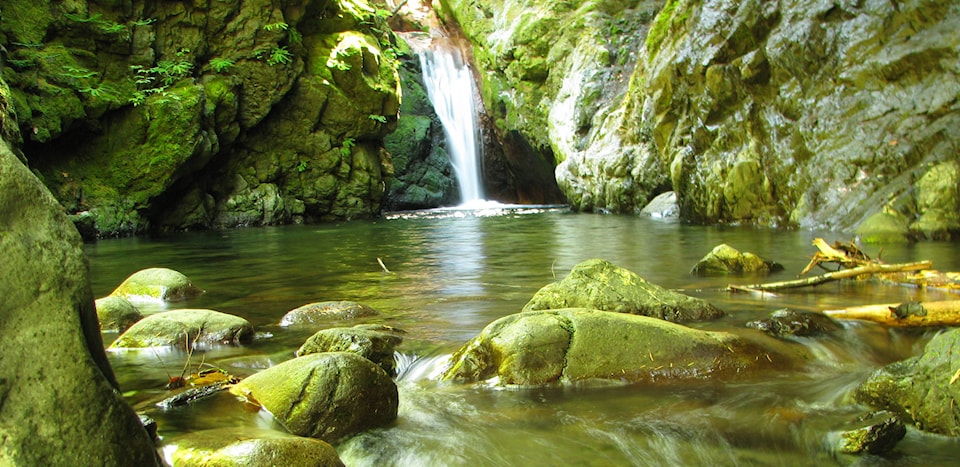SANDY MCRUER
SPECIAL TO THE NEWS
I can’t believe that going into the fourth year of doing this column, I haven’t talked about Fossli Provincial Park!
Well it’s high time, because it is a beautiful place to hike or paddle at any time of year. There are quite a number of features, including an eroded old logging road which took off the original forest, a small suspension bridge over a creek coming off the mountain, a waterfall and a beach on Sproat Lake. It’s a great place to spend an afternoon exploring.
Albert Faber, the first settler to take possession of the property in 1888, gave it the name Fossli, which he claimed meant “waterfall in a valley.” But there may be more to the story than that. Google translate tells me that the phrase is “foss i en dal” in Norwegian. It turns out that there is a famous hotel in Norway called Fossli Hotel that overlooks one of the tallest and most famous waterfalls in Europe: Voringsfoss. However, it was built three years after Faber arrived here.
There are two ways to get to the park: by boat or by trail. There is no road access. By boat, from Sproat Lake Provincial Park boat launch, paddle southwest around Faber Point and enter Stirling Arm. It’s on the south shore of Sproat Lake. It should take an hour or so.
By trail is a little more complicated. It’s 4.8 km from the turnoff onto the logging road off Stirling Arm Drive. Take the first right once you are on the mainline. If you cross St. Andrews Creek, you’ve gone a little too far.
The rustic parking area is marked by a painted brown post with vertical lettering in white. The trail winds down along an old logging spur-road along the edge of some recent logging. The forest leading down regenerated from the original logging 60-some years ago. The road is pretty eroded, so watch your footing. Further on, the trail turns left off the road and leads down to the suspension bridge.
Once across the bridge, you have entered the park. The forest changes to an older one, perhaps 100 years old. You can see signs of the old springboards used by the first men to cut the trees. You wander along the top of a bluff above a flat populated by a magnificent stand of Bigleaf Maple. A turnoff to the right leads down to that flat and the creek below the waterfall, Fossli Falls. It’s not big. But it is exquisite, pouring out through a cleft into a plunge-pool below. The trail leads downstream along the creek bank with several spots to climb on the cobbles and search for crayfish, or just hang out. Thick layers of moss wrap the trunks of huge old Bigleaf Maples. And large logs sometimes lie across the trail. Just as the trail bends away from the creek, the creek itself sinks into the loose gravel of the small delta that has formed from all the gravel and woody debris like logs and stumps that have washed down over the ages.
Beyond the creek, the trail moves into an area where Mr. Faber once grew potatoes. It is a uniform stand of alder with the most ancient, gnarled maple you’ve ever seen in the middle. Huge limbs have grown out, and their ends have broken off. Other limbs have grown straight up off the original limb, looking like trees themselves. It looks as if an owl or even a spirit might dwell within it.
The path continues through the alder and around the base of a small hill coming out at a small beach. The view looks northward toward the Beaufort Mountains and Mount Porter, the ridge that separates Sproat Lake from Great Central Lake. The shoreline across the lake is lined with houses of the well-to-do residents of the Valley and a few summer homes often rented out in the winter.
The beach itself slides gently into the water at a perfect angle to land a kayak, canoe or even a motor boat if the motor is tilted up. The water is warm in the summer, great for splashing around in the shallows or hunting crayfish. Watch out for those pincers!
Back from the beach there is a little clearing from the cottage that used to be here. There is an outhouse and a picnic table nearby. There’s also a little plaque dedicated to Mr. and Mrs. Armour Ford. They bequeathed the property to the Province so that this beautiful gem of a park can be enjoyed by the public for the foreseeable future. It was a wonderful gift.
